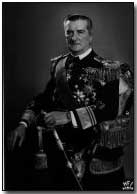Who's Who - Miklos Horthy de Nagybanya
 Miklos Horthy de Nagybanya
(1868-1957) was born into a family of landed gentry. Having entered the
Austro-Hungarian navy he served as an aide-de-camp to the Emperor, Franz
Josef, prior to the First World War.
Miklos Horthy de Nagybanya
(1868-1957) was born into a family of landed gentry. Having entered the
Austro-Hungarian navy he served as an aide-de-camp to the Emperor, Franz
Josef, prior to the First World War.
With war declared Horthy was made captain of the cruiser Novara towards the close of 1914, in which he established a name as a bold, aggressive commander in numerous surface actions.
Having (probably) planned the raid that resulted in the Otranto Straits action of May 1917, Horthy emerged with renewed fame and credit. So much so that following the mutiny at Cattaro in March 1918, followed by the forced resignation of Admiral Njegovan, Horthy found himself promoted Rear Admiral and appointed Commander in Chief (Austria-Hungary's last) of the battlefleet over the heads of many more qualified officers.
Notwithstanding this rapid promotion Horthy distinguished himself in his new role by re-energising the by then war weary fleet. Having gained the trust and moreover improved the morale of the fleet, Horthy took care to maintain the stability of the fleet as a deterrent force. At the same time, so as to keep his forces in trim, he reacted to occasional Italian light raids.
The only large-scale offensive operation undertaken by Horthy at this time occurred in June 1918, and was directed against the Otranto Barrage. However this was quickly abandoned following the loss of the dreadnought Szent Istvan.
Fortunately this setback did not affect the loyalty of the fleet until orders came from the Emperor, Karl I, on 31 October requiring him to hand over the fleet to the Yugoslav National Council.
With the disintegration of the Austro-Hungarian empire Horthy returned to Hungary, where he successfully led an uprising against the Communist government of Bela Kun. His forces entered Budapest in November 1919; Horthy established himself as regent the following March, a position he held until the Nazi occupation of 19 March 1944.
Staying on nevertheless as a figurehead, in August 1944 Horthy removed the puppet Nazi government, appointing in its place a government tasked with achieving an armistice. With such an armistice signed in Moscow, Horthy's attempt to enforce it on 15 October met with determined (and successful) German resistance.
Having been arrested by the Gestapo, Horthy and his family were removed to Germany. He served as a witness at the Nuremberg trials following the war, but was unable to return to Hungary given its Soviet occupation and new Communist government.
Thereafter in exile in Estoril, Portugal, Horthy died in 1957. With the departure of the last Soviet soldier from Hungary in 1993, Horthy was reburied in the town of his birth, Kenderes.
An Armlet was a cloth band worn around the arm to identify a particular duty or function.
- Did you know?
